|
 Another 6 A.M. wake-up then a decision to give breakfast a try. As usual,
the food was good and the line was long. I can certainly deal with
standing in line for a few days - especially when I'm surrounded by
professionals.
Another 6 A.M. wake-up then a decision to give breakfast a try. As usual,
the food was good and the line was long. I can certainly deal with
standing in line for a few days - especially when I'm surrounded by
professionals.
|
|
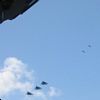
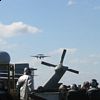

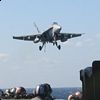
 The wind & waves were enough to cancel plans for a ship to ship
replenishment demonstration and put the rest of the scheduled air show at
risk. But, after everything was considered, plans to "recover"
14 airplanes moved forward. Landing on a carrier is called
"recovery" and I didn't have to think too long to realize that
it's a pretty good name for it. The weather did keep the planes circling a
bit extra and there were a few flagged off attempts but eventually all
were safely on board. The prop-driven Hawkeye was the first plane
recovered. It's somewhat slower than the jets, so maybe this is a test. My
location wasn't very good for getting pictures of the planes as they
touched down but I could certainly see, hear, & feel them and did
manage a few photos. All of these planes were part of the group that had
gone to & from the middle-east with the Enterprise and which had been
flown from the ship to their land bases shortly before the ship docked in
Mayport.
The wind & waves were enough to cancel plans for a ship to ship
replenishment demonstration and put the rest of the scheduled air show at
risk. But, after everything was considered, plans to "recover"
14 airplanes moved forward. Landing on a carrier is called
"recovery" and I didn't have to think too long to realize that
it's a pretty good name for it. The weather did keep the planes circling a
bit extra and there were a few flagged off attempts but eventually all
were safely on board. The prop-driven Hawkeye was the first plane
recovered. It's somewhat slower than the jets, so maybe this is a test. My
location wasn't very good for getting pictures of the planes as they
touched down but I could certainly see, hear, & feel them and did
manage a few photos. All of these planes were part of the group that had
gone to & from the middle-east with the Enterprise and which had been
flown from the ship to their land bases shortly before the ship docked in
Mayport.
|
|
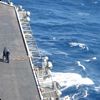
 From the vantage point of a floating airport, keeping sizes in perspective
isn't easy. That's no rowboat out there. That's the 446 foot long USS
Laramie that was to participate in the canceled replenishment. Earlier
reports had the waves at 12 feet and I can't tell you whether these are
higher or lower. Whatever the height of the waves, the water is anything
but smooth. Watching the planes approach the ship before landing can
actually be deceiving. As the pilots maintain their trajectory toward the
deck, it's easy to lose sight of the fact that the deck is slowly bobbing
up and down several feet.
From the vantage point of a floating airport, keeping sizes in perspective
isn't easy. That's no rowboat out there. That's the 446 foot long USS
Laramie that was to participate in the canceled replenishment. Earlier
reports had the waves at 12 feet and I can't tell you whether these are
higher or lower. Whatever the height of the waves, the water is anything
but smooth. Watching the planes approach the ship before landing can
actually be deceiving. As the pilots maintain their trajectory toward the
deck, it's easy to lose sight of the fact that the deck is slowly bobbing
up and down several feet.
|
|
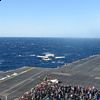
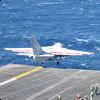
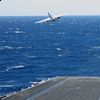 When the planes launched, I found myself, thanks to Fletcher & Joe,
with a view from the tower. I had to maintain that vantage point for quite
some time before the first plane took off and the 40+ MPH over the deck
winds took their toll. Watching the planes leap into the air was
incredible but I was ready to head inside before all were airborne. We
moved to the Public Affairs Office and that allowed me to experience the
sound of fighter jets taking off from the roof over my head. By
comparison, the loudest upstairs neighbor is just a whimper.
When the planes launched, I found myself, thanks to Fletcher & Joe,
with a view from the tower. I had to maintain that vantage point for quite
some time before the first plane took off and the 40+ MPH over the deck
winds took their toll. Watching the planes leap into the air was
incredible but I was ready to head inside before all were airborne. We
moved to the Public Affairs Office and that allowed me to experience the
sound of fighter jets taking off from the roof over my head. By
comparison, the loudest upstairs neighbor is just a whimper.
|
|

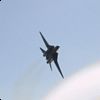

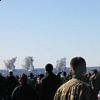 Once all planes were launched, we were treated to an Air Power
Demonstration. Quite a few of the air wing's weapons, defensive as well as
offensive, were shown. Pictured here are a "wall of water"
bombing run, mid-air refueling, and a high speed short radius turn. The
demonstration also included an F-14 super-sonic pass with its accompanying
boom. These were common in the '50s but are just about unknown to younger
generations. The show's finale was a diamond formation fly over.
Once all planes were launched, we were treated to an Air Power
Demonstration. Quite a few of the air wing's weapons, defensive as well as
offensive, were shown. Pictured here are a "wall of water"
bombing run, mid-air refueling, and a high speed short radius turn. The
demonstration also included an F-14 super-sonic pass with its accompanying
boom. These were common in the '50s but are just about unknown to younger
generations. The show's finale was a diamond formation fly over.
|
|




 Tigers were divided into three tour groups based on the pictures on their
badges then assigned a starting point based on the color. I was a purple
F-14. An early tour stop was one of the galleys where thousands of meals
are turned out daily. And those meals are quite good. In February, the
Enterprise picked up the annual Captain Edward Ney Award for Food Service
Excellence. We also stopped by the barber shop and the plastic disposal
area. Scrap plastic isn't actually disposed of here but is formed into
easily stored disks until the ship returns to port.
Tigers were divided into three tour groups based on the pictures on their
badges then assigned a starting point based on the color. I was a purple
F-14. An early tour stop was one of the galleys where thousands of meals
are turned out daily. And those meals are quite good. In February, the
Enterprise picked up the annual Captain Edward Ney Award for Food Service
Excellence. We also stopped by the barber shop and the plastic disposal
area. Scrap plastic isn't actually disposed of here but is formed into
easily stored disks until the ship returns to port.
Unlike the Public Affairs Department, the Personnel Department was not
actually working during with the Tigers on board so many of the
"volunteers" involved in Tiger activities were from there. That
was the case with our tour guide whose mother was a member of the tour.
I'm not sure of all the details but the mom decided to leave the tour
rather early and so did the daughter. As a result, Fletcher
"volunteered" to serve as guide for the rest of the tour.
|
|




 Climbing up the tower, we visited Primary Flight Control - Pri Fly.
Planes are tracked on the vertical clear plastic panel by someone writing
backwards on one side so it can be read from the other. Excellent views
of both landing and launch areas are available to the Air Boss and Mini
Boss sitting in comfortable (I tested the Mini Boss chair) elevated seats.
I'm not sure of the names of the other three areas pictured here. The
first is sort of the surface version of flight control. Every aircraft on
board is tracked with small models on the accurate deck layout on the
table. Craft in the hangars are tracked on a shelf below. Equipment
conditions and requirements are indicated by color and
"accessories" such as a nut or small bolt. Not surprisingly, on
newer carriers, tools like this table and Pri Fly's panel are replaced by
electronic gadgets. The Enterprise is, you'll recall, about forty years
old.
Climbing up the tower, we visited Primary Flight Control - Pri Fly.
Planes are tracked on the vertical clear plastic panel by someone writing
backwards on one side so it can be read from the other. Excellent views
of both landing and launch areas are available to the Air Boss and Mini
Boss sitting in comfortable (I tested the Mini Boss chair) elevated seats.
I'm not sure of the names of the other three areas pictured here. The
first is sort of the surface version of flight control. Every aircraft on
board is tracked with small models on the accurate deck layout on the
table. Craft in the hangars are tracked on a shelf below. Equipment
conditions and requirements are indicated by color and
"accessories" such as a nut or small bolt. Not surprisingly, on
newer carriers, tools like this table and Pri Fly's panel are replaced by
electronic gadgets. The Enterprise is, you'll recall, about forty years
old.
The next picture shows where parachutes, flotation vests, and survival
kits are packed. The last picture is of the cylinders that operate the
wires that capture landing airplanes. On this cruise, my son often took
pictures of Adventure Bear to send home to his own son. Here Adventure
Bear and I listen to the presentation together.
|
|

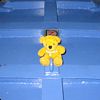


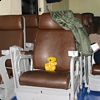 Here is the Hall of Heroes where every room is named for an aviator lost
from the Enterprise. The rooms are where visiting V.I.P.s are quartered.
Next it was all the way forward to th fo'c'sle where things like very big
chains and very big anchors are handled. Adventure Bear takes a break at
the very center of the fo'c'sle's forward bulkhead. The final tour stop
is the F-14 Tomcat Ready Room. As the tour went up & down ladders and
into meal time, members dropped off until only a half dozen or so
remained. Each air squadron has a ready room and all were on the tour
agenda. There was hardly time or apparent desire to visit them all but
Fletcher asked the group what they wanted to do. One fellow wanted to see
the Tomcats so the remaining two men and a boy plus Fletcher and myself,
got the last Tomcat presentation of the cruise. Adventure Bear even got a
seat in the front row.
Here is the Hall of Heroes where every room is named for an aviator lost
from the Enterprise. The rooms are where visiting V.I.P.s are quartered.
Next it was all the way forward to th fo'c'sle where things like very big
chains and very big anchors are handled. Adventure Bear takes a break at
the very center of the fo'c'sle's forward bulkhead. The final tour stop
is the F-14 Tomcat Ready Room. As the tour went up & down ladders and
into meal time, members dropped off until only a half dozen or so
remained. Each air squadron has a ready room and all were on the tour
agenda. There was hardly time or apparent desire to visit them all but
Fletcher asked the group what they wanted to do. One fellow wanted to see
the Tomcats so the remaining two men and a boy plus Fletcher and myself,
got the last Tomcat presentation of the cruise. Adventure Bear even got a
seat in the front row.
|
|